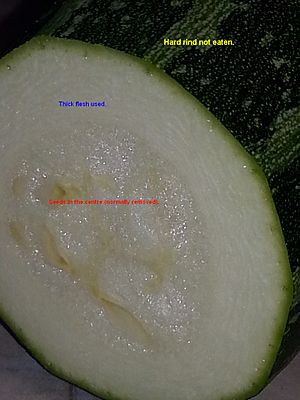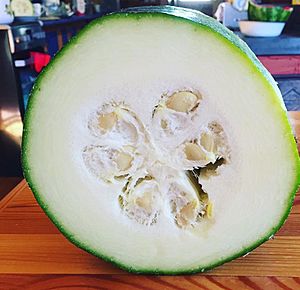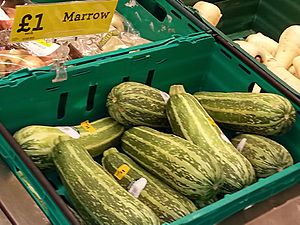Marrow (vegetable) facts for kids

The thick flesh of a vegetable marrow is used in the UK.
|
|
| Type | Vegetable |
|---|---|
| Place of origin | United Kingdom |
A marrow is a type of vegetable. It is the fully grown fruit of certain Cucurbita pepo plants. When these same plants produce younger, smaller fruits, they are called courgettes (in places like Britain and France) or zucchini (in North America and Australia).
Marrows look like long, green squash. They have a tough skin and a mild taste. Because of their mild flavor, they are often used to hold tasty fillings like mincemeat. You can store marrows for several weeks after picking them, just like pumpkins. They are a popular vegetable in Great Britain and other areas with British influence. However, younger, more tender courgettes are becoming more popular.
Some people in the United Kingdom grow giant marrows for competitions. The word "marrow" often refers to the striped, thick-skinned type of this vegetable. Even though we eat marrows as a vegetable, they are actually a fruit in a botanical sense. They are a kind of botanical berry that grows from the flower's ovary. Like all squash, marrows originally came from the Americas.
History of Marrows
The word "vegetable marrow" was first used in 1822. The terms "zucchini" and "courgette" came much later, in the 1920s and 1930s. Before plants from the Americas arrived, the word "marrow" referred to the young, edible fruits of Lagenaria. This was a type of gourd from Africa. People grew it long ago to eat when young or to dry and use as waterproof containers.
Marrows are commonly grown in the British Isles. The striped, thicker-skinned type is especially well-known there. However, in North America (since the 1920s) and Britain (since the 1960s), thinner-skinned, younger marrows have become popular. These are known as immature marrows or courgettes. They are liked for their soft skin and unique taste. An old book from 1928 mentioned that the "English Vegetable Marrow" was one of the first types of marrow squash grown, but it was "never exceedingly popular" in America.
The trend of eating young marrows, called "courgettes" in Britain, is quite new there. In the 1960s, some gardening books didn't even mention courgettes. But others described them as "very tender baby marrows" that had been popular in France for a long time. They were seen as something new and exciting in Britain.
A man named William Gibbs holds the world record for growing the largest marrow. He grew a giant marrow that weighed an amazing 128 pounds! He was known as a master grower.
Marrow Nutrition
Marrows, like zucchini, are low in calories. They have about 17 kcal (71 kJ) for every 100 grams of fresh marrow. They also contain good amounts of important nutrients. These include folate (24 μg per 100 g), potassium (261 mg per 100 g), and provitamin A (200 IU per 100 g).
Important Safety Information
Plants in the Cucurbitaceae family, which includes marrows, zucchini, pumpkins, and cucumbers, can sometimes contain natural chemicals called cucurbitacins. These chemicals are a type of steroid. They help protect the plants from animals that might want to eat them. To humans, these chemicals taste very bitter.
The marrows and other squash we buy in stores are usually grown to have very low levels of these bitter chemicals, so they are safe to eat. However, some ornamental pumpkins, which are grown for decoration and not for eating, can have high levels of cucurbitacins. If these ornamental plants cross-pollinate with edible squash, the seeds from that cross might produce bitter and unsafe fruits the next season.
Also, if a plant is stressed by dry weather or not enough water, it might produce more of these bitter chemicals. Cooking does not remove these toxins. It's very important to know that if a marrow or any squash tastes unusually bitter, you should not eat it. Eating very bitter squash can make you sick.




